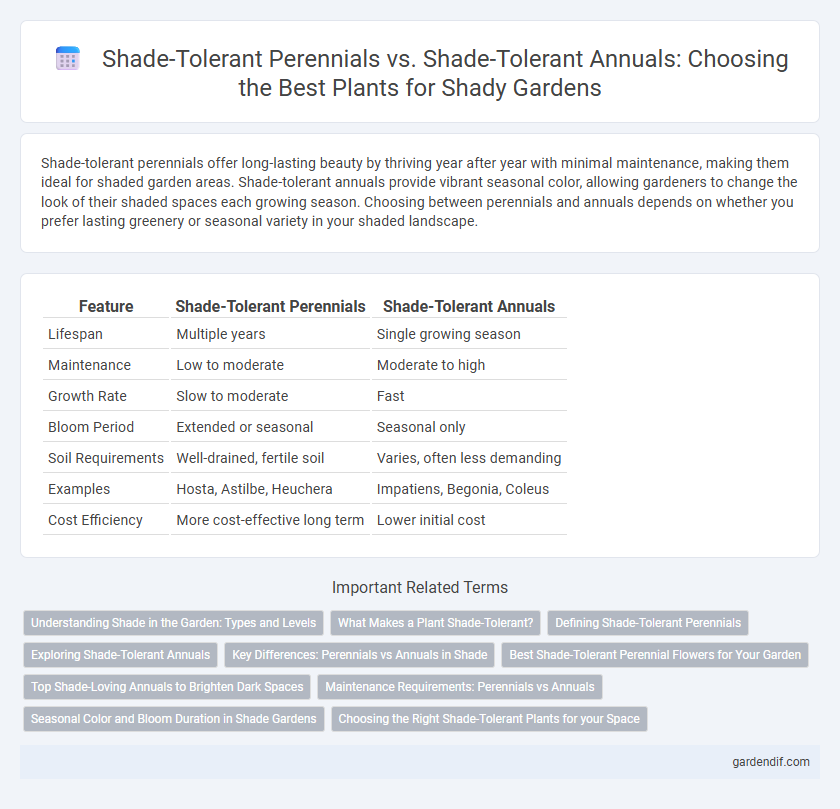
shade-tolerant perennials vs shade-tolerant annuals Illustration
Shade-tolerant perennials offer long-lasting beauty by thriving year after year with minimal maintenance, making them ideal for shaded garden areas. Shade-tolerant annuals provide vibrant seasonal color, allowing gardeners to change the look of their shaded spaces each growing season. Choosing between perennials and annuals depends on whether you prefer lasting greenery or seasonal variety in your shaded landscape.
Table of Comparison
| Feature | Shade-Tolerant Perennials | Shade-Tolerant Annuals |
|---|---|---|
| Lifespan | Multiple years | Single growing season |
| Maintenance | Low to moderate | Moderate to high |
| Growth Rate | Slow to moderate | Fast |
| Bloom Period | Extended or seasonal | Seasonal only |
| Soil Requirements | Well-drained, fertile soil | Varies, often less demanding |
| Examples | Hosta, Astilbe, Heuchera | Impatiens, Begonia, Coleus |
| Cost Efficiency | More cost-effective long term | Lower initial cost |
Understanding Shade in the Garden: Types and Levels
Shade-tolerant perennials such as hostas and ferns thrive in low-light conditions by adapting to dappled or indirect sunlight, providing year-round garden structure and reducing maintenance needs. In contrast, shade-tolerant annuals like impatiens and begonias offer vibrant seasonal color in areas with partial to full shade but require replanting each year. Understanding the types of shade--dense, filtered, or partial--and their intensity helps gardeners select appropriate plants based on light availability and garden design goals.
What Makes a Plant Shade-Tolerant?
Shade-tolerant plants possess adaptations such as large, thin leaves that maximize light absorption and chlorophyll concentrations optimized for low-light conditions. Perennials develop extensive root systems and slower growth rates to thrive in shade longer-term, while shade-tolerant annuals prioritize rapid life cycles to complete growth during limited light availability. These adaptations allow shade-tolerant species to efficiently photosynthesize and survive under canopy or low-light environments.
Defining Shade-Tolerant Perennials
Shade-tolerant perennials are plants that thrive in low-light conditions and return year after year, adapting their growth to shaded environments. Unlike shade-tolerant annuals, which complete their life cycle in one season, perennials establish deep root systems and provide long-term garden stability under canopy cover. Common examples include hostas, ferns, and astilbes, which maintain foliage and bloom even with limited sunlight.
Exploring Shade-Tolerant Annuals
Shade-tolerant annuals such as impatiens, begonias, and coleus thrive in low-light conditions by completing their life cycle within a single growing season, offering vibrant color and diversity to shaded gardens. Unlike shade-tolerant perennials that provide long-term structure and repeated bloom cycles, annuals fill seasonal gaps and adapt quickly to varying shade intensities. These annuals are essential for gardeners seeking immediate visual impact and flexibility in shaded landscapes.
Key Differences: Perennials vs Annuals in Shade
Shade-tolerant perennials, such as hostas and ferns, thrive over multiple growing seasons, requiring less replanting and offering consistent foliage in shaded landscapes. Shade-tolerant annuals, including impatiens and begonias, complete their life cycle in one season, providing vibrant seasonal color but needing annual replacement. Perennials develop deeper root systems, enhancing soil stability and moisture retention under shade, while annuals are often preferred for quick, temporary shade gardening solutions.
Best Shade-Tolerant Perennial Flowers for Your Garden
Shade-tolerant perennial flowers such as Hostas, Astilbes, and Heucheras offer long-lasting color and texture, thriving in low-light garden areas year after year. These perennials require less maintenance compared to shade-tolerant annuals like Impatiens and Begonias, which must be replanted each season. Incorporating shade-tolerant perennials in garden design optimizes soil health, conserves water, and enhances biodiversity in shaded landscapes.
Top Shade-Loving Annuals to Brighten Dark Spaces
Top shade-loving annuals such as impatiens, begonias, and fuchsias thrive in low-light conditions, bringing vibrant color to dark garden spaces where shade-tolerant perennials may take longer to establish. These annuals provide quick, seasonal bursts of bright blooms, making them ideal for adding immediate visual interest under dense tree canopies or shaded patios. Their ability to flourish in indirect light ensures continuous color throughout the growing season, enhancing shaded areas that often lack lively foliage.
Maintenance Requirements: Perennials vs Annuals
Shade-tolerant perennials typically require less maintenance than shade-tolerant annuals, as they establish deep root systems that enhance soil stability and reduce watering frequency over time. Annuals, while providing vibrant color throughout the growing season, demand regular replanting, consistent watering, and more frequent fertilization to thrive in shaded environments. The long-term care efficiency of perennials often makes them a more sustainable choice for shaded garden areas with lower maintenance needs.
Seasonal Color and Bloom Duration in Shade Gardens
Shade-tolerant perennials provide long-lasting seasonal color with bloom durations often extending from spring through fall, offering a consistent visual appeal in shade gardens. Shade-tolerant annuals typically deliver vibrant, intense color bursts but for shorter periods, often limited to a single growing season or bloom cycle. Combining both perennials and annuals ensures continuous seasonal color and maximizes bloom duration in shaded landscapes.
Choosing the Right Shade-Tolerant Plants for your Space
Shade-tolerant perennials thrive by returning year after year, offering long-term structure and stability in low-light garden areas. Shade-tolerant annuals provide vibrant seasonal color and variety but require replanting each year, ideal for flexible or evolving landscape designs. Selecting the right shade-tolerant plants depends on factors like garden size, maintenance preferences, and desired visual impact, with perennials suited for permanence and annuals for dynamic displays.
shade-tolerant perennials vs shade-tolerant annuals Infographic

 gardendif.com
gardendif.com